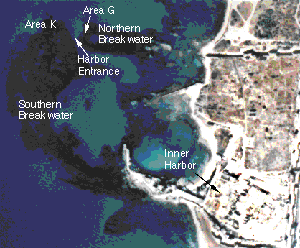

In 21 BC, King Herod the Great, ruler of the Jewish state of Judea, commissioned and built an all-weather harbor at Caesarea. He hoped to ingratiate himself to the new ruler of Rome, Caesar Augustus, and at the same time to satisfy some of his economic needs.
The construction of the harbor was difficult due to natural constraints presented by the Israeli coastline ( Israeli Coastline ). The coast is straight, with no natural topography that could be expanded upon to build a harbor. However, Herod's engineers succeeded in building an all-weather harbor by using hydraulic concrete, a new Roman building material, to construct breakwaters extending out into the sea. ( A View of Herod's Harbor ). Construction of the harbor took twelve years. Herod named the completed city Caesarea and the harbor Sebastos (Greek for Augustus) (Details on Harbor Construction ).
Archaeological evidence suggests that the city of Caesarea had a bustling harbor at least up to the mid to late first century. However, findings suggest the outer harbor had some problems towards the end of the 1st century AD which affected harbor use. Currently, there is no conclusive evidence to indicate whether these problems were due to natural or human-induced causes.
The Herodian breakwaters are presently submerged 5m below the water surface. It is believed that tectonic activity caused the submergence, since there are two fault lines that run through the harbor, generally, in a north-south direction. The timing of the breakwaters' submergence has not been definitively described, although it is known that by 500 AD the harbor was in poor condition since around that time, Procopius of Gaza, an early Christian bishop, complained to the Roman Emperor Anastasius (491-518 AD) that the harbor was in a poor state. Procopius wrote that he used to watch ships wreck regularly in the exposed harbor.
This report has been substantiated by the discovery of the remains of several shipwrecks on the harbor moles. The majority of the wrecks have diagnostic pottery sherds that have a possible date range from the third to sixth centuries AD. At least one wreck that was carrying lead ingots, (Details on Lead Ingots ) has been dated to the end of the 1st century AD. This finding indicates that portions of the outer harbor had already deteriorated at least a century after the harbor was built.
Therefore, based on Procopius' writings, by the sixth century a significant portion of the harbor breakwaters must have been under the waves. Unfortunate vessels were wrecked when they tried to navigate over the submerged breakwater debris. However, not long after Procopius' account, Emporer Anastasius financed the refurbishment of the harbor.
The harbor at Caesarea had many forms during its history. The different morphologies were the result of human and natural alterations of the harbor structures and the coastal environment. The harbor was used in variable forms and capacities right up to the Crusader period (1265 AD) after which it was destroyed and abandoned (Chronological Timeline ).
Excavation last season examined:
1. the arrangement of the well-preserved wooden caissons (barges) that held the hydraulic concrete for the harbor breakwaters; and
2. the harbor sediments for micropaleontological and sedimentological analysis (Paleoenvironmental Project).
Similar research will continue furing this upcoming field season in 1996.